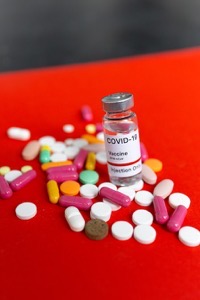In marketing there’s not such thing as a lie, it’s an expedient exaggeration.
Cary Grant in Afred Hitchcock’s North by Northwest
 The pharmaceutical industry have very effective marketing departments who have turned science into an expedient exaggeration.
The pharmaceutical industry have very effective marketing departments who have turned science into an expedient exaggeration.
The industry generates $1.48 trillion annually[1]Global pharmaceutical industry – statistics & facts. It is subject to regulations that require it to conduct trials before any medication is made available for prescription. It is the way that the parmaceutical industry circumvents these regulations that discredits the science.
The starting point is the failings in the regulations which require that a medication is not better than what already exists, but merely that it is better than nothing.
When the patent for a drug expires, and the price drops, all the company need do is make a change to the formulation, register a new patent, and prove that the changed drug is better than nothing – and then using marketing convince the public, and of course the prescribing doctors, that the new drug is an improvement – which is why drugs enjoy such extensive marketing.
The “new” drug is no better than the old drug, just a lot more expensive.
Then there are the statistics. A drug is advertised as reducing the possibility of having a cardiovascular event by 50%. And that’s true. Except that this is in populations who enjoy an extremely low probability of 0.37% and it drops to 0.18% – turning a 0.17% improvement into the 50% that is advertised. That also does not take account of the cost of taking the medication daily, and the side effects of the drug. Exercise and good diet have a far better impact on the probabilities, but the advertising won’t tell you that.
Then, there are the ways in which trials are selected for publication. If you have multiple trials, then publishing only those with results that flatter the drug is bad science. And that is what they do.
Then, there are the seeding trials. These are trials run by the marketing departments of the pharmaceutical companies, not their scientists. Doctors are selected to prescribe the trial drug, each to a small group of their patients, who are told that they are acting in the interest of science.
The two most notorious examples are STEPS[2]Study of neurontin: titrate to effect, profile of safety (STEPS) trial: a narrative account of a gabapentin seeding trial and ADVANTAGE[3]The ADVANTAGE seeding trial: a review of internal documents, which were “trials” managed and orchestrated by the marketing departments of the their respective manufacturers for the drugs Vioxx and Gabapentin. Vioxx was later withdrawn for creating an increased risk of cardiac events. Gabapentin has an extensive list of serious adverse side effects[4]Gabapentin.
In both cases, because the trials were not conducted scientifically, the serious side effects were only discovered after the drugs had been released for prescription in the general population. People died as human guinea pigs, without having given their consent. The authorities failed us, as did the doctors who participated in the trials. The pharmaceutical companies betrayed us.
Of course, lessons have been learned. Before they embark in this kind of mendacity, the marketing departments consult the legal departments, and they make sure that the kind of correspondence that proved their responsibility in these cases does not exist. Or they make sure that governments indemnify them against prosecutions, as happened with COVID.
The pharmaceutical companies have proven that their primary objectives are profits. Our lives don’t matter to them.
More reading:
Bad Pharma: How Drug Companies Mislead Doctors and Harm Patients
Seeding trials: Marketing gimmick or credible scientific research
Pharmaceutical marketing research and the prescribing physician
Marketing trials, marketing tricks – how to spot them and how to stop them
Narrative review: the promotion of gabapentin: an analysis of internal industry documents
